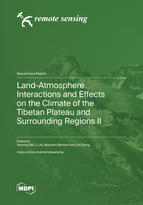Land-Atmosphere Interactions and Effects on the Climate of the Tibetan Plateau and Surrounding Regions II
A special issue of Remote Sensing (ISSN 2072-4292). This special issue belongs to the section "Atmospheric Remote Sensing".
Deadline for manuscript submissions: closed (1 June 2023) | Viewed by 28394
Special Issue Editors
Interests: water cycle; evapotranspiration and evaporation; atmospheric boundary layer; satellite remote sensing application
Special Issues, Collections and Topics in MDPI journals
Interests: earth observations for terrestrial water cycle study; evapotranspiration; water resource; land surface process; optical-thermal remote sensing; climate change
Special Issues, Collections and Topics in MDPI journals
2. Department of Geoscience and Remote Sensing, Faculty of Civil Engineering and Geosciences, Delft University of Technology, 2628 Delft, The Netherlands
Interests: land surface processes; terrestrial water cycle; water management; optical remote sensing
Special Issues, Collections and Topics in MDPI journals
Interests: application of remote sensing; energy and water cycle; land-atmosphere interaction; hydrometorology; atmospheric boundary layer process
Special Issues, Collections and Topics in MDPI journals
Special Issue Information
Dear Colleagues,
This is the 2nd volume of the Special Issue “Land-Atmosphere Interactions and Effects on the Climate of the Tibetan Plateau and Surrounding Regions”, it was a great success. Based on the previous research results, this volume is aimed at the presentation of recent advances in Land-Atmosphere interactions and effects on the climate of the Tibetan Plateau and surrounding regions.
The Tibetan Plateau is also known as the roof of the world and the third pole of the Earth. Energy and water exchange at the heterogeneous interface of the plateau land surface with the atmosphere is great and rapidly varying. This land–atmosphere interaction has profound impacts on atmospheric circulation and climate conditions over the Tibetan Plateau and its surrounding regions, as well. In the context of global warming, the Tibetan Plateau itself is becoming warmer and wetter. In recent decades, both polar orbiting and geostationary satellites have been providing vital information to form a better understanding of land–atmosphere interactions and the related climate effects in the third pole region. Large research efforts have been focusing on the retrieval of key land-surface properties, i.e., land-surface temperature, NDVI, albedo, soil moisture, and land-surface heat fluxes. These observations are a vital source of information to monitor the variations in snow, glaciers, lakes, and other hydro-meteorological processes on the Tibetan Plateau. A rapidly growing body of knowledge documents how land–atmosphere interactions and their climatic effects have been revealed using multispectral, hyperspectral, thermal, and microwave remote sensing data.
This Special Issue will showcase successful recent endeavors in studies covering applications of multisource remote sensing data regarding land–atmosphere interactions and their effects on the climate of the Tibetan Plateau and Surrounding Regions. The subject relates to the multi-disciplinary intersection of atmospheric and hydro-meteorological science with remote sensing. It fits well within the scope of the journal.
Contributions may address research questions ranging from the retrieval of land-surface variables and land-surface heat fluxes at different spatial and temporal scales to the monitoring of variations in snow, glaciers, lakes, and other land-surface covers. Hence, studies focused on land-surface processes, hydro-meteorological processes, and their climate impacts based on the combined use of multisource data, e.g., remote sensing data and in situ measurements, are welcome. Articles may address but are not limited to the following topics:
- Retrieval of land-surface key properties;
- Estimation of land-surface heat fluxes;
- Land-surface heating and its impacts on the atmospheric boundary layer;
- Estimation of atmospheric heating sources;
- Climate effects of land–atmosphere interactions;
- Parameterization of radiation fluxes;
- Evapotranspiration modeling;
- Time series analysis and effect studies;
- Monitoring of glacier and glacial lakes;
- Remote sensing of hydrological processes;
- Vegetation dynamics and its response to weather and climate; and
- Remote sensing-based drought assessment and monitoring.
Prof. Dr. Yaoming Ma
Prof. Dr. Li Jia
Prof. Dr. Massimo Menenti
Prof. Dr. Lei Zhong
Guest Editors
Manuscript Submission Information
Manuscripts should be submitted online at www.mdpi.com by registering and logging in to this website. Once you are registered, click here to go to the submission form. Manuscripts can be submitted until the deadline. All submissions that pass pre-check are peer-reviewed. Accepted papers will be published continuously in the journal (as soon as accepted) and will be listed together on the special issue website. Research articles, review articles as well as short communications are invited. For planned papers, a title and short abstract (about 100 words) can be sent to the Editorial Office for announcement on this website.
Submitted manuscripts should not have been published previously, nor be under consideration for publication elsewhere (except conference proceedings papers). All manuscripts are thoroughly refereed through a single-blind peer-review process. A guide for authors and other relevant information for submission of manuscripts is available on the Instructions for Authors page. Remote Sensing is an international peer-reviewed open access semimonthly journal published by MDPI.
Please visit the Instructions for Authors page before submitting a manuscript. The Article Processing Charge (APC) for publication in this open access journal is 2700 CHF (Swiss Francs). Submitted papers should be well formatted and use good English. Authors may use MDPI's English editing service prior to publication or during author revisions.
Keywords
- land–atmosphere interactions
- radiation flux
- sensible and latent heat fluxes
- land-surface heating
- atmospheric heating sources
- atmospheric boundary layer
- climate effects
- evapotranspiration
- land-surface temperature
- vegetation dynamics
- soil moisture
- machine learning
- validation and evaluation









